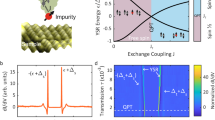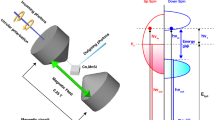Abstract
An individual magnetic atom doped into a semiconductor is a promising building block for bottom-up spintronic devices and quantum logic gates1,2,3. Moreover, it provides a perfect model system for the atomic-scale investigation of fundamental effects such as magnetism in dilute magnetic semiconductors4. However, dopants in semiconductors so far have not been studied by magnetically sensitive techniques with atomic resolution that correlate the atomic structure with the dopant’s magnetism. Here we show electrical excitation and read-out of a spin associated with a single magnetic dopant in a semiconductor host. We use spin-resolved scanning tunnelling spectroscopy to measure the spin excitations and the magnetization curve of individual iron surface-dopants embedded within a two-dimensional electron gas confined to an indium antimonide (110) surface. The dopants act like isolated quantum spins the states of which are governed by a substantial magnetic anisotropy that forces the spin to lie in the surface plane. This result is corroborated by our first principles calculations. The demonstrated methodology opens new routes for the investigation of sample systems that are more widely studied in the field of spintronics—that is, Mn in GaAs (ref. 5), magnetic ions in semiconductor quantum dots3, nitrogen-vacancy centres in diamond6 and phosphorus spins in silicon7.
This is a preview of subscription content, access via your institution
Access options
Subscribe to this journal
Receive 51 print issues and online access
$199.00 per year
only $3.90 per issue
Buy this article
- Purchase on Springer Link
- Instant access to full article PDF
Prices may be subject to local taxes which are calculated during checkout




Similar content being viewed by others
References
Tang, J.-M., Levy, J. & Flatté, M. E. All-electrical control of single ion spins in a semiconductor. Phys. Rev. Lett. 97, 106803 (2006)
Hanson, R. & Awschalom, D. D. Coherent manipulation of single spins in semiconductors. Nature 453, 1043–1049 (2008)
Le Gall, C. et al. Optical spin orientation of a single manganese atom in a semiconductor quantum dot using quasiresonant photoexcitation. Phys. Rev. Lett. 102, 127402 (2009)
Kitchen, D., Richardella, A., Tang, J.-M., Flatté, M. E. & Yazdani, A. Atom-by-atom substitution of Mn in GaAs and visualization of their hole-mediated interactions. Nature 442, 436–439 (2006)
Yakunin, A. M. et al. Warping a single Mn acceptor wavefunction by straining the GaAs host. Nature Mater. 6, 512–515 (2007)
Neumann, P. et al. Quantum register based on coupled electron spins in a room-temperature solid. Nature Phys. 6, 249–253 (2010)
Fuechsle, M. et al. Spectroscopy of few-electron single-crystal silicon quantum dots. Nature Nanotechnol. 5, 502–505 (2010)
Žutić, I., Fabian, J. & Das Sarma, S. Spintronics: fundamentals and applications. Rev. Mod. Phys. 76, 323–410 (2004)
Awschalom, D. D. & Flatté, M. E. Challenges for semiconductor spintronics. Nature Phys. 3, 153–159 (2007)
Kane, B. E. A silicon-based nuclear spin quantum computer. Nature 393, 133–137 (1998)
Loss, D. & DiVincenzo, D. P. Quantum computation with quantum dots. Phys. Rev. A 57, 120–126 (1998)
Hirjibehedin, C. F. et al. Large magnetic anisotropy of a single atomic spin embedded in a surface molecular network. Science 317, 1199–1203 (2007)
Heinrich, A. J., Gupta, J. A., Lutz, C. P. & Eigler, D. M. Single-atom spin-flip spectroscopy. Science 306, 466–469 (2004)
Loth, S. et al. Controlling the state of quantum spins with electric currents. Nature Phys. 6, 340–344 (2010)
Balashov, T. et al. Magnetic anisotropy and magnetization dynamics of individual atoms and clusters of Fe and Co on Pt(111). Phys. Rev. Lett. 102, 257203 (2009)
Chen, X. et al. Probing superexchange interaction in molecular magnets by spin-flip spectroscopy and microscopy. Phys. Rev. Lett. 101, 197208 (2008)
Tsukahara, N. et al. Adsorption-induced switching of magnetic anisotropy in a single iron(II) phthalocyanine molecule on an oxidized Cu(110) surface. Phys. Rev. Lett. 102, 167203 (2009)
Meier, F., Zhou, L., Wiebe, J. & Wiesendanger, R. Revealing magnetic interactions from single-atom magnetization curves. Science 320, 82–86 (2008)
Wiebe, J. et al. A 300 mK ultra-high vacuum scanning tunneling microscope for spin-resolved spectroscopy at high energy resolution. Rev. Sci. Instrum. 75, 4871–4879 (2004)
Hashimoto, K. et al. Quantum Hall transition in real space: from localized to extended states. Phys. Rev. Lett. 101, 256802 (2008)
Mochizuki, T., Masutomi, R. & Okamoto, T. Evidence for two-dimensional spin-glass ordering in submonolayer Fe films on cleaved InAs surfaces. Phys. Rev. Lett. 101, 267204 (2008)
Whitman, L. J., Stroscio, J. A., Dragoset, R. A. & Celotta, R. J. Scanning-tunneling-microscopy study of InSb(110). Phys. Rev. B 42, 7288–7291 (1990)
Stipe, B. C., Rezaei, M. A. & Ho, W. Single-molecule vibrational spectroscopy and microscopy. Science 280, 1732–1735 (1998)
Fernández-Rossier, J. Theory of single-spin inelastic tunneling spectroscopy. Phys. Rev. Lett. 102, 256802 (2009)
Fransson, J. Spin inelastic electron tunneling spectroscopy on local spin adsorbed on surface. Nano Lett. 9, 2414–2417 (2009)
Persson, M. Theory of inelastic electron tunneling from a localized spin in the impulsive approximation. Phys. Rev. Lett. 103, 050801 (2009)
Lorente, N. & Gauyacq, J.-P. Efficient spin transitions in inelastic electron tunneling spectroscopy. Phys. Rev. Lett. 103, 176601 (2009)
Zhou, L. et al. Strength and directionality of surface Ruderman-Kittel-Kasuya-Yosida interaction mapped on the atomic scale. Nature Phys. 6, 187–191 (2010)
Harris, J. G. E. et al. Magnetization measurements of magnetic two-dimensional electron gases. Phys. Rev. Lett. 86, 4644 (2001)
Acknowledgements
J.W. would like to thank M. Morgenstern, and S.S. would like to thank M. Karolak for discussions. A.A.K. acknowledges M. Grobis for technical discussions. We gratefully acknowledge financial support from the ERC Advanced Grant “FURORE”, by the Deutsche Forschungsgemeinschaft via the SFB668, the Graduiertenkolleg 1286 “Functional Metal-Semiconductor Hybrid Systems”, as well as by the city of Hamburg via the cluster of excellence “Nanospintronics”. All DFT calculations were done at the North-German Supercomputing Alliance (HLRN).
Author information
Authors and Affiliations
Contributions
A.A.K. and B.C. performed the experiments. A.A.K., B.C. and J.W. did the data analysis. B.C. did the modelling. S.S. did the DFT calculations. J.W., A.A.K. and B.C. wrote the paper. All authors discussed the results and commented on the manuscript.
Corresponding author
Ethics declarations
Competing interests
The authors declare no competing financial interests.
Supplementary information
Supplementary Information
The file contains Supplementary Methods, a Supplementary Discussion, Supplementary References and Supplementary Figures 1-2 with legends. (PDF 238 kb)
Rights and permissions
About this article
Cite this article
Khajetoorians, A., Chilian, B., Wiebe, J. et al. Detecting excitation and magnetization of individual dopants in a semiconductor. Nature 467, 1084–1087 (2010). https://doi.org/10.1038/nature09519
Received:
Accepted:
Published:
Issue Date:
DOI: https://doi.org/10.1038/nature09519
This article is cited by
-
Doping-dependent charge- and spin-density wave orderings in a monolayer of Pb adatoms on Si(111)
npj Quantum Materials (2024)
-
Improved anticorrosion performance of mixed valence Mn-modified ZnO dilute magnetic solid solution with multilevel self-assembled network structure
Nano Research (2022)
-
Creating designer quantum states of matter atom-by-atom
Nature Reviews Physics (2019)
-
An orbitally derived single-atom magnetic memory
Nature Communications (2018)
-
Imaging Atomic Scale Dynamics on III–V Nanowire Surfaces During Electrical Operation
Scientific Reports (2017)
Comments
By submitting a comment you agree to abide by our Terms and Community Guidelines. If you find something abusive or that does not comply with our terms or guidelines please flag it as inappropriate.



